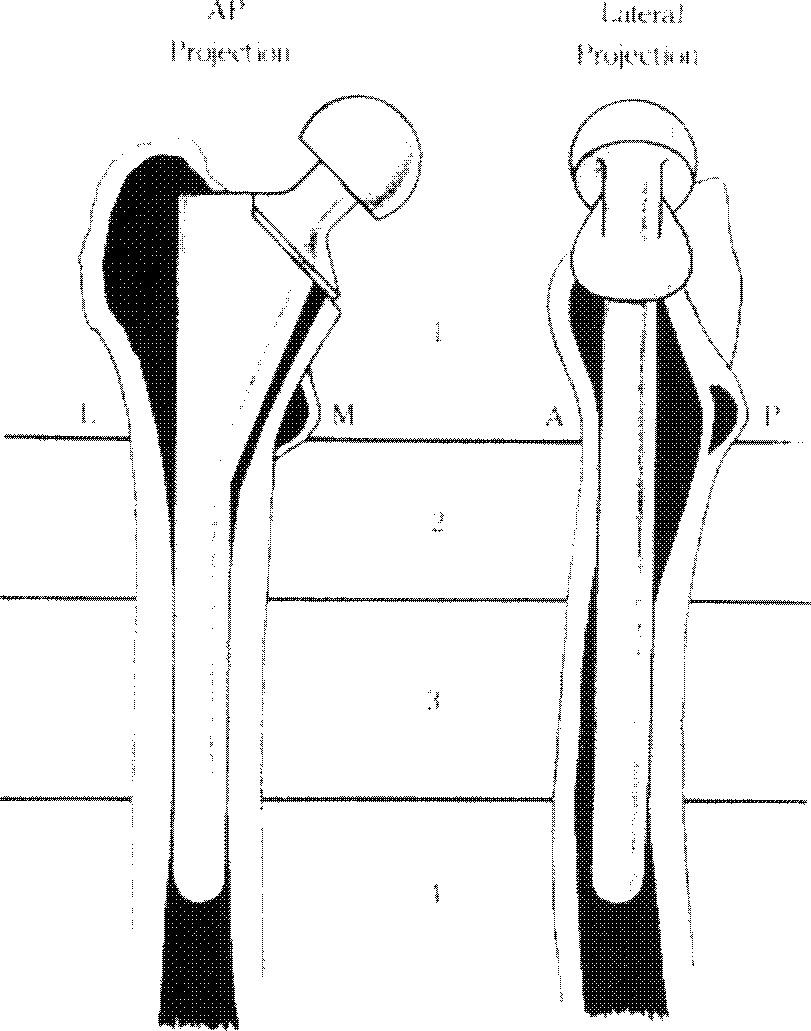J Korean Orthop Assoc.
1996 Apr;31(2):336-344. 10.4055/jkoa.1996.31.2.336.
Femoral Bone Resorption after Cementless Total Hip Arthroplasty
- KMID: 2423612
- DOI: http://doi.org/10.4055/jkoa.1996.31.2.336
Abstract
- Bone resorption around femoral stem as an effect of stress shielding and a subsequent adaptive remodeling process is a disturbing phenomenon. The purpose of this study is to analysis the degree, the location and the time of appearance of femoral bone resorption after cementless total hip replacement and to evaluate the factors affecting the degree, the location and the time of appearance of bone resorption. The authors analysed total 48 cases of standard radiographies which underwent operation between September, 1983 to May, 1994 at Korea University, Guro Hospital and the mean duration of follow up was average 16 months(range 7 months to 5 years). The results were as follows; 1. Bone resorption could be observed mostly in proximal portion of femur and the extent was limited to the first and the second degree according to Engh's classification in most cases. 2. The degree of bone resorption was significantly correlated with the diameter of femoral stem. 3. The time of appearance of bone resorption after THR was not statistically correlated with the diameter of femoral stem. 4. The degree of bone resorption was not related with sex, age, preoperative diagnosis, type of femoral stem and degree of press-fitting. In conclusion bone resorption as an adaptive bone remodeling process after cementless total hip replacement could be observed in the proximal femur, and the factors affecting the degree of bone resorption were closely related with the size of femoral stem, but not related with sex, preoperative diagnosis, press-fitting and type of femoral stem. From the mechanical point of view, we could conclude that the bending stiffness of a prosthesis was the most important factor affecting the degree of bone resorption.
Keyword
MeSH Terms
Figure
Reference
-
5. Beaupre GS, Orr TE, Carter DR. An approach for time-dependent bone modeling and remodeling application, A preliminary remodeling simulation. J Orthop. Res,. 1990; 85:662–670.6. Bobyn JD, Glassman AH, Goto H, Krygier JJ, Miller JE, Brook CE. The effect of stem stiffness on femoral bone resorption after canine porous coated total hip arthroplasty. Clin Orthop. 1990; 261:196–213.7. Carter DR. Mechanical loading history and skeletal biology. J Biomechanics. 1987; 20:1095–1110.
Article8. Bobyn JD. The influence of stem size & extent of porous coating on femoral bone resorption after primary cementless hip arthroplasty. Clin. Orthop. 1988; 231:7–28.9. Bobyn JD. Principles, techaniques, results and complications with a porous coated metal stems. 1986. The American Academy of Orthopedic Surgeons & ICL XXXV:;St. Louis, The C.V.Mosby;p. 169–183.10. Glassman AH. Porous coated hip replacement. The factors governing bone ingrowth, stress shielding and clinical results. J Bone Joint Surg. 1987; 69B:45–55.11. Engh CA, McGovern TF, Bobyn JD, Harris WH. A quantitative evaluation of periprosthetic bone remodelling after cementless total hip arthroplasty. J Bone Joint Surg. 74-A:1009–1111. 1992.12. Galante JO. Determinants of stress shielding-design vs.materials vs.interface. The Hip Scciety, 19th Open Scientific Meeting, Anaheim, CA March 10. 1991.13. Haddad RJ, Cook SD, Thomas KA. Biologic fixation of porous coated implants. J Bone Joint Surg,. 1987; 69-A:1459–1466.14. Hughes SS, Furia JP, Smith P, Pellegrini YD. Atrophy of the proximal part of the femur after total hip arthroplasty without cement-a quantitative comparison of cobalt-chromium and titanium femoral stem with use of dual x-ray absorptiometry. J Bone Joint Surg. 1995; 77A:231–239.15. Huiskes R, Grootenboer HJ. . Adaptive bone remodeling theory applied to prosthetic-design analysis. J Biomechanics. 1987; 20((11/12)):1135–1150.16. Huiskes R. The various stress patterns of press-fit ingrowth and cemented femoral stems. Clin Orthokp. 1990; 261:27–38.17. Huiskes R, Weinans H, Rietbergens B. The relationship between stress shielding and bone resorption around total hip stems and the effects of flexible materials. Clin Orthop. 1992; 274:124–134.
Article18. Kiratli BJ, Heiner JP, Mcbeath AA. Femoral bone mineral density changes in THA patients with up to seven year follow-up determinations. Trans. Orthop. Res Soc. 1992; 17:238.19. McCarthy CK, Steinberg GG, Agren M, Leahey D, Wyman E, Baran DT. Quantifying bone loss from the proximal femur after total hip arthroplasty. J Bone Joint Surg. 1991; 73-B((5)):774–778.
Article20. Pellegrini VD, Hughes SS, Evarts C. McC : A collariess cobalt chrome femoral component in uncemented total hip arthroplasty five to eight-year follow-up. J Bone Joint Surg. 1992; 74-B((6)):814–821.21. Rohlmann A, Cheal EJ, Hayes WC, Bergmann G. A nonlinear finite element analysis of interface conditions in porous coated hip endoprosthesis. J Biomechanics. 1988; 1605–611.22. Rubin PJ, Rakotomanana RL, Leyvraz PF, Zysset PK, Curnierk A, Heegard JH. Factional interface micromotions and anisotropic stress distribution in a femoral total hip component. J Biomechanics. 1993; 26:725–39.23. Turner TM, Summer DR, Urban RM, et al. A Comparative study of porous coating in a weight-bearing total hip arthroplasty model. J Bone Joint Surg,. 68A:1396–1409. 1986.24. Weinans H, Huiskes R, van Rietbergen B, Sumner DR, Turner T.M., Galante JO. Adaptive bone remodeling around bonded noncemented THA:a comparison between animal experiment and computer simulation. J Orthop Res. 1993; 11:500–513.
- Full Text Links
- Actions
-
Cited
- CITED
-
- Close
- Share
- Similar articles
-
- Cementless Total Hip Arthroplasty in Long Term Steroid-Induced Avascular Necrosis of the Hip
- A clinical study of the thigh pain and bone resorption in cementless hip arthroplasty
- Midterm Results of Total Hip Arthroplasty Using the VerSys Fiber Metal Tapered Femoral Stem
- Total Hip Arthroplasty with F2L Multineck Cementless Femoral Stem
- The Clinical and Radiologic Results of Total Hip Arthroplasty with an AML Hip Prosthesis: Minimum 7 Years' Follow-up Study


